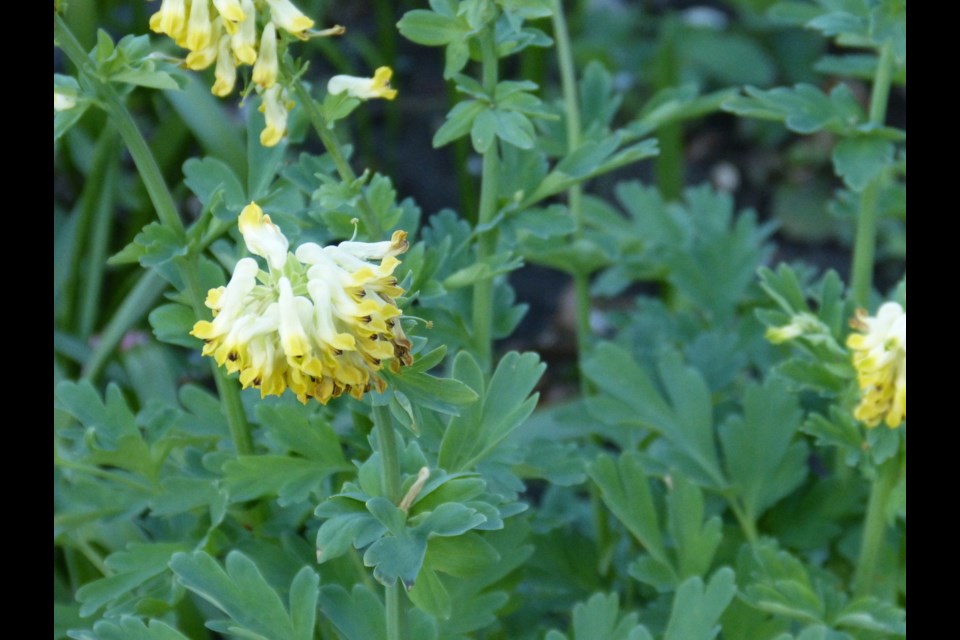We’ll conclude our series on spring flowering perennials with globeflower, corydalis and hepatica. Last, but not least! And no spring garden should be without them.
Globeflower (Trollius spp.)
Trollius is one of the very few botanical names that is not based on Latin or Greek. It is from the Swiss-German trollblume, and, like the common English name, means a round flower. Native to the mountain meadows of Europe and Asia, they are hardy, trouble-free, and long-lived, forming slowly increasing clumps.
Varying in height from 30 to 80 cm (12-32 in.), they form neat, erect clumps of dark green, lobed or divided foliage. The globe-shaped or buttercup-like flowers are single or double. Their colour ranges from bright orange to almost white. They are fibrous-rooted.
Globeflowers require well-drained but evenly moist soil to which generous amounts of organic matter have been added. They grow best in full sun but will also do well in partial shade. They do struggle in heat or drought.
Place them in a perennial border or a waterside or bog garden. They are easily increased through division just after flowering.
Common or European globeflower (T. europaeus), native to the moist meadows of Europe and Britain, has lemon to buttery-yellow flowers and dark green, palmately divided, deeply toothed foliage. The plants range from 30 to 70 cm (12-28 in.) in height.
Trollius x cultorum hybrids generally have globe-form flowers with their sepals rolled in, larger flowers, and good foliage. Among the varieties are: ‘Alabaster’, ‘Cheddar’, ‘Earliest of All’, ‘Lemon Queen’, ‘New Moon’, ‘Orange Princess’ and ‘Superbus’.
Ledebour trollius (T. ledebourii), native to Siberia, Korea and Mongolia, is usually available as ‘Golden Queen’ with deep orange, bowl-shaped flowers on plants 45 to 60 cm (18-24 in.) in height.
Dwarf globeflower (T. pumila), native to the Himalayan Mountains of northern India and China, forms small clumps of about 25 cm (10 in.) in height, with clear yellow, single flowers that open flat.
Noble fumitory, noble corydalis (Corydalis nobilis)
Here is a lovely perennial, one of the earliest to bloom, which should have a place in every northern garden. Sadly, it is seldom seen in our gardens. The blue-flowered corydalis is more readily available but is not reliably hardy in most northern regions.
First introduced to Europe in 1783, the noble corydalis is native to central Asia and Siberia. It forms leafy mounds of attractive, ferny, pinnately compound foliage with a blue-green cast. The flowers, in large dense racemes, are bright yellow with a brown tip, each with four petals, one of which is spurred. They appear in early spring on 45 to 60 cm (18-24 in.) stems. By early summer corydalis has entered dormancy, leaving not a trace until it emerges the following spring.
They do well in full sun to partial shade in well-drained soil with even moisture. Mark their position and take care not to place another plant over them once they become dormant.
This is a good border plant to place adjacent to a perennial that will modestly spread into the space vacated by the corydalis by midsummer. They are also well suited to the edge of a woodland or a shade garden. They self-seed in a very gentle and limited way.Liverwort, liverleaf (Hepatica spp.)
Gardeners may complain about Latin names, but given a choice, there is no doubt that I would name a daughter Hepatica rather than Liverleaf or Liverwort. All of these names describe the leaves, said to resemble a human liver. The Greek word hepar means liver, while wort means a cure for. Both are based on the early medieval “Doctrine of Signatures,” wherein the signature or characteristic of a plant indicated its medicinal use as a cure. Thus, Hepatica was said to cure ailments of the liver. Hepaticas are lovely, hardy, and long-lived perennials that should be seen much more often in our northern gardens.
Place them in semi- to full shade in humus-rich but well-drained soil with a pH above neutral. Provide them with even moisture. Hepatica self-seed gently or can be divided. They are ideal for a shaded rock garden or a woodland garden.
Hepatica nobilis, 10 to 15 cm (4-6 in.) in height, is native to the subalpine deciduous forests of Europe and western Asia. The solitary, blue, pink, red, or white flowers appear above the previous season’s foliage in early spring. There are also double forms. The almost evergreen, dark green, basal leaves are three-lobed and develop after the flowers; they remain attractive throughout the growing season. The following are similar to the species except in flower colour: ‘Alba’ is white, ‘Rubra’ red, and ‘Rosea’ pink.
Transylvanian hepatica (H. transsilvanica) is very similar but is a more robust and spreading plant, and larger in all of its parts (15 cm/6 in. in height) than the noble liverleaf. Its azure blue flowers appear about a week later than H. nobilis. Its leaves are scalloped and pubescent.
Sara Williams is the author and co-author of many books including Creating the Prairie Xeriscape, Gardening Naturally with Hugh Skinner and, with Bob Bors, the recently published Growing Fruit in Northern Gardens. She continues to give workshops on a wide range of gardening topics throughout the prairies.
This column is provided courtesy of the Saskatchewan Perennial Society (SPS; [email protected] ). Check our website (www.saskperennial.ca) or Facebook page (www.facebook.com/saskperennial) for a list of upcoming gardening events




